Abstract
Evaluation and delivery of physical activity and exercise programs appear impeded by the substantial numbers of Americans who are unwilling or unable to participate regularly in physical activity. As a step toward identifying effective interventions, we reviewed available research on determinants relating to the adoption and maintenance of physical activity. We categorized determinants as personal, environmental, or characteristic of the exercise. We have considered supervised participation separately from spontaneous activity in the general population. A wide variety of determinants, populations, and settings have been studied within diverse research traditions and disciplines. This diversity and the varied interpretation of the data hinder our clearly summarizing the existing knowledge. Although we provide some directions for future study and program evaluation, there is a need for research that tests hypotheses derived from theoretical models and that has clear implications for intervention programs. We still need to explore whether general theories of health behavior or approaches relating to specific exercises or activities can be used to predict adoption and maintenance of physical activity.
Full text
PDF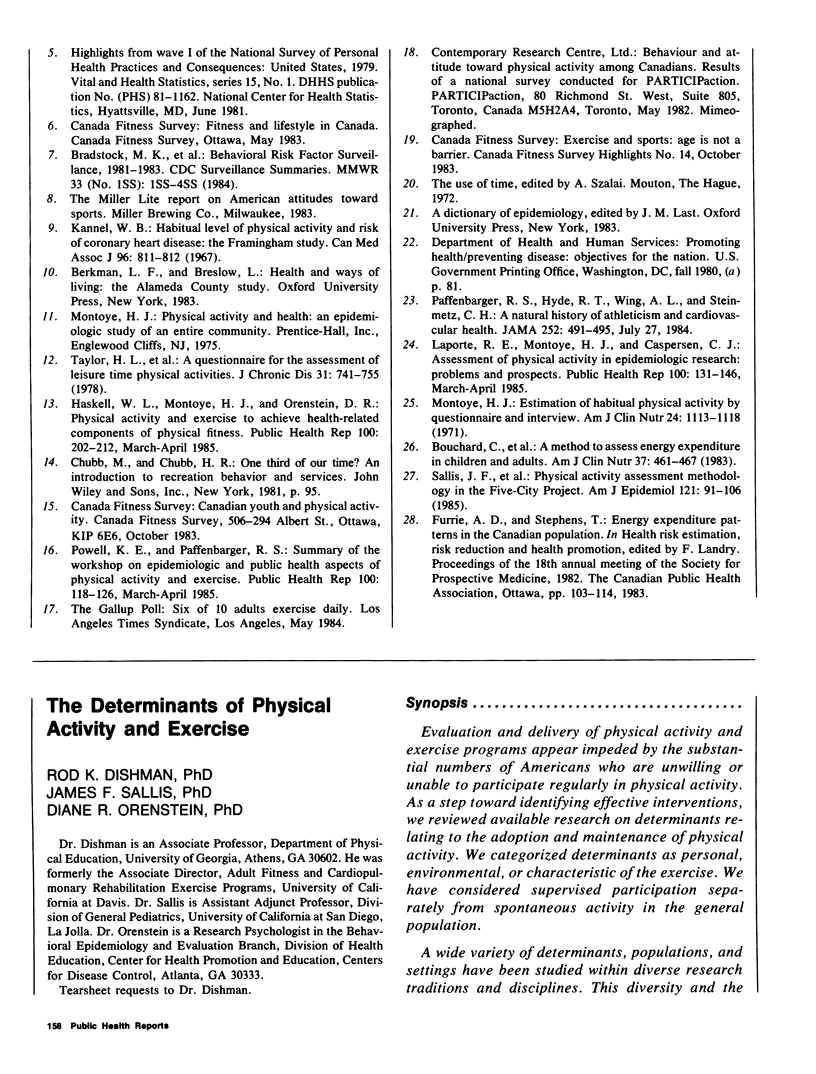
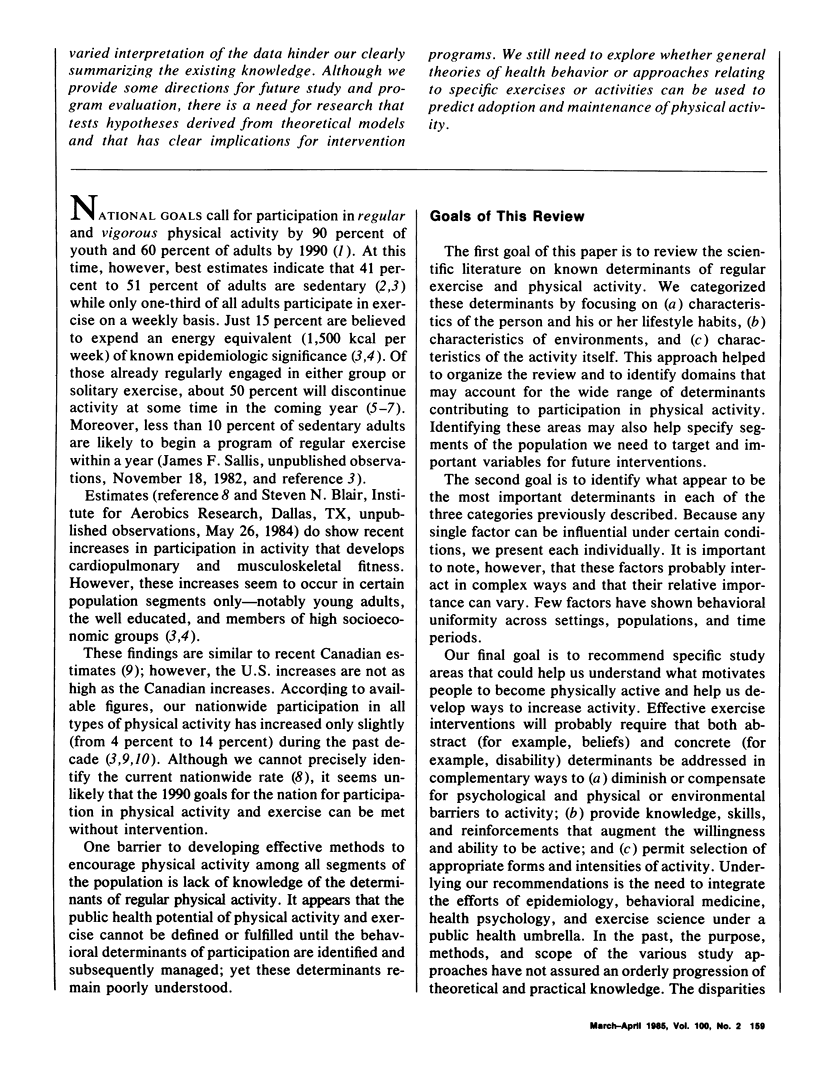
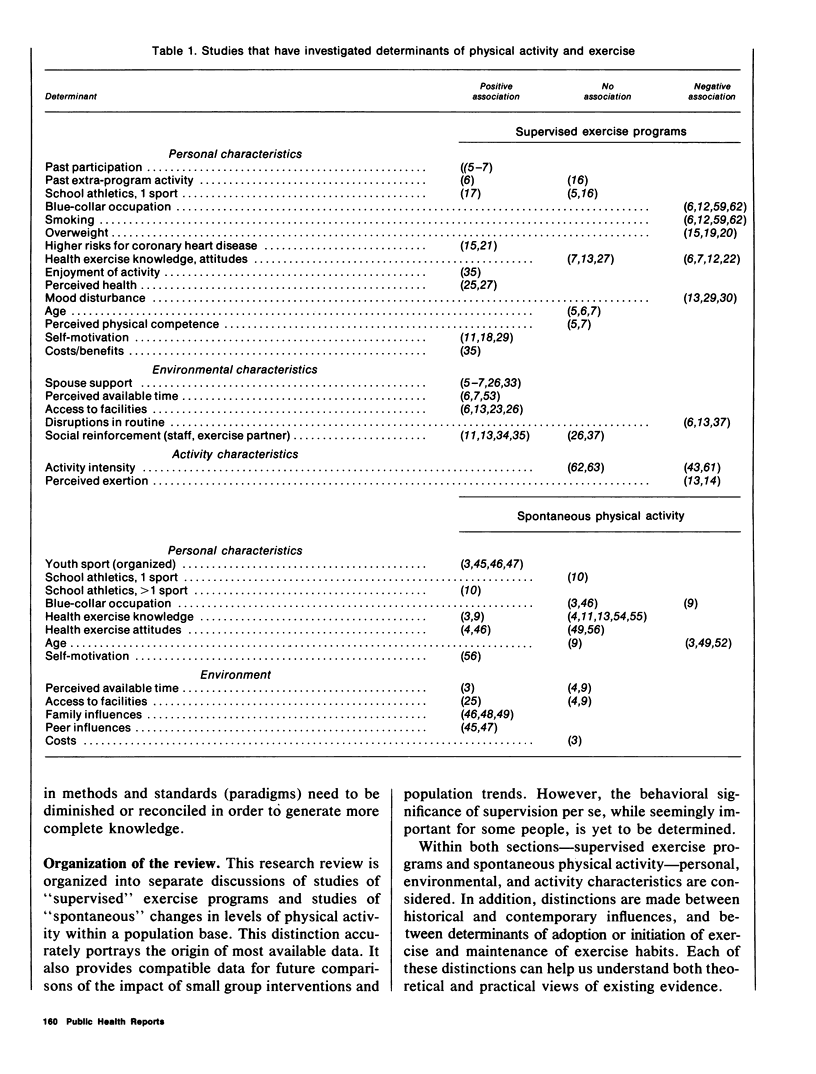
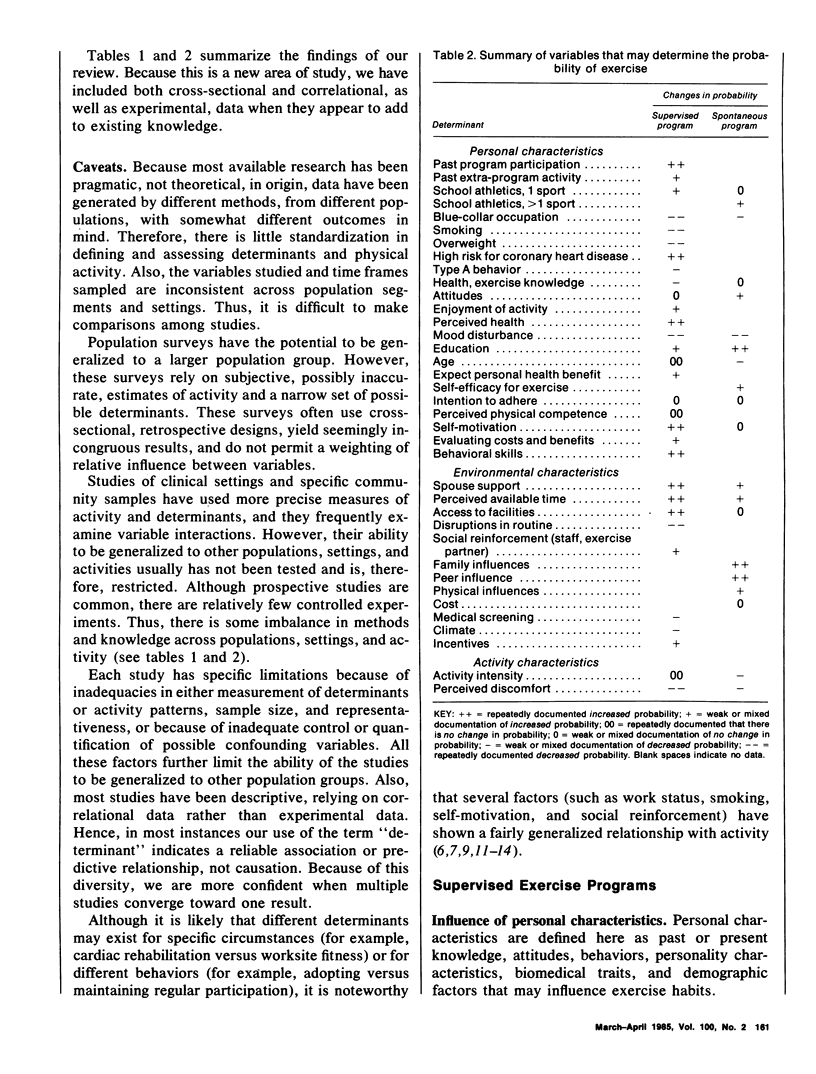
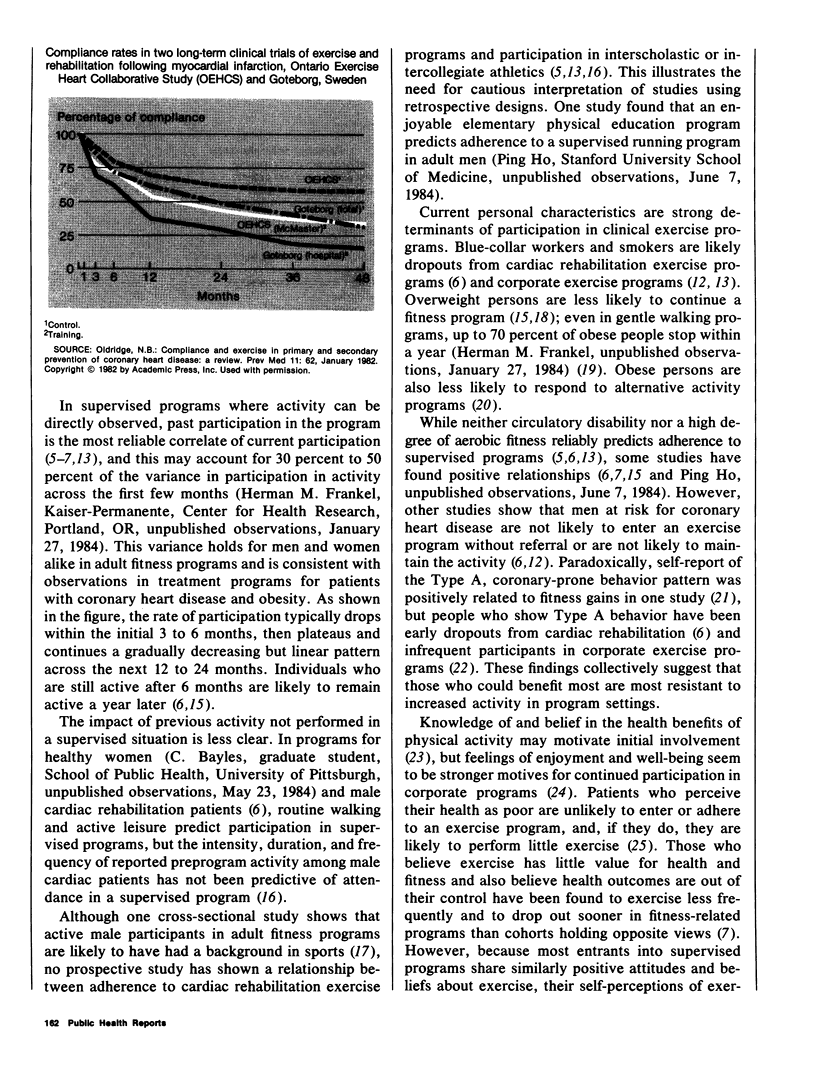
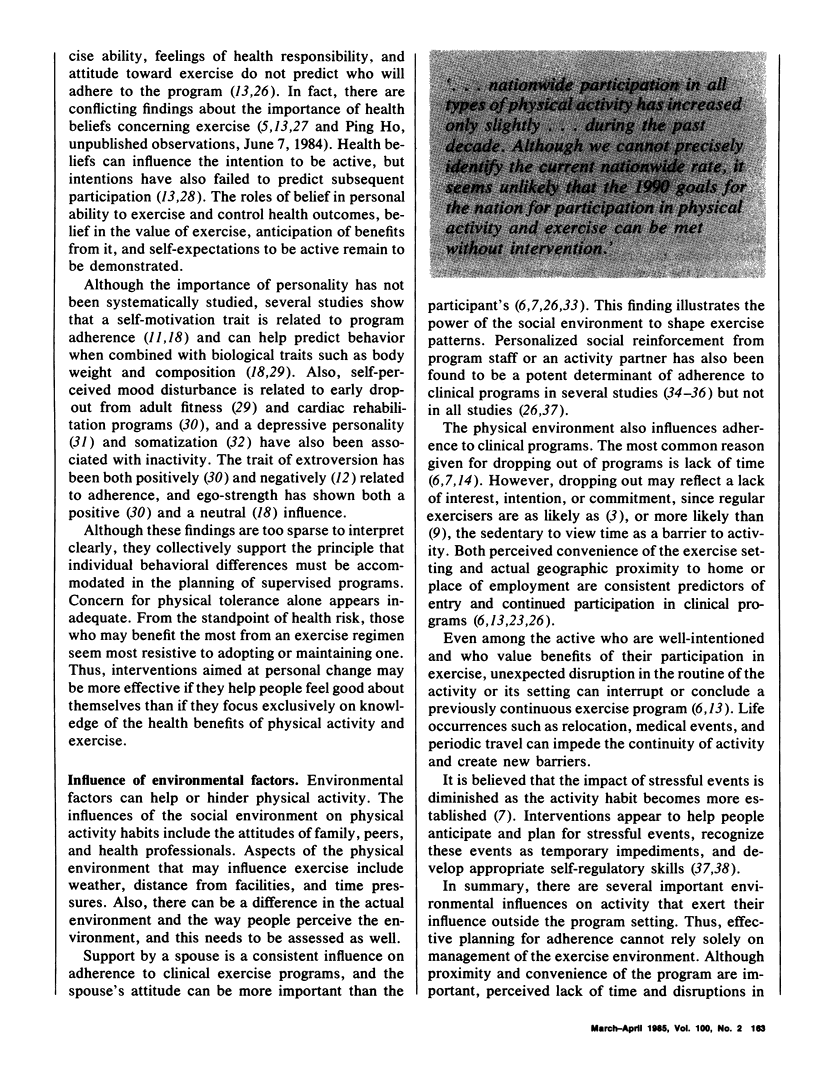
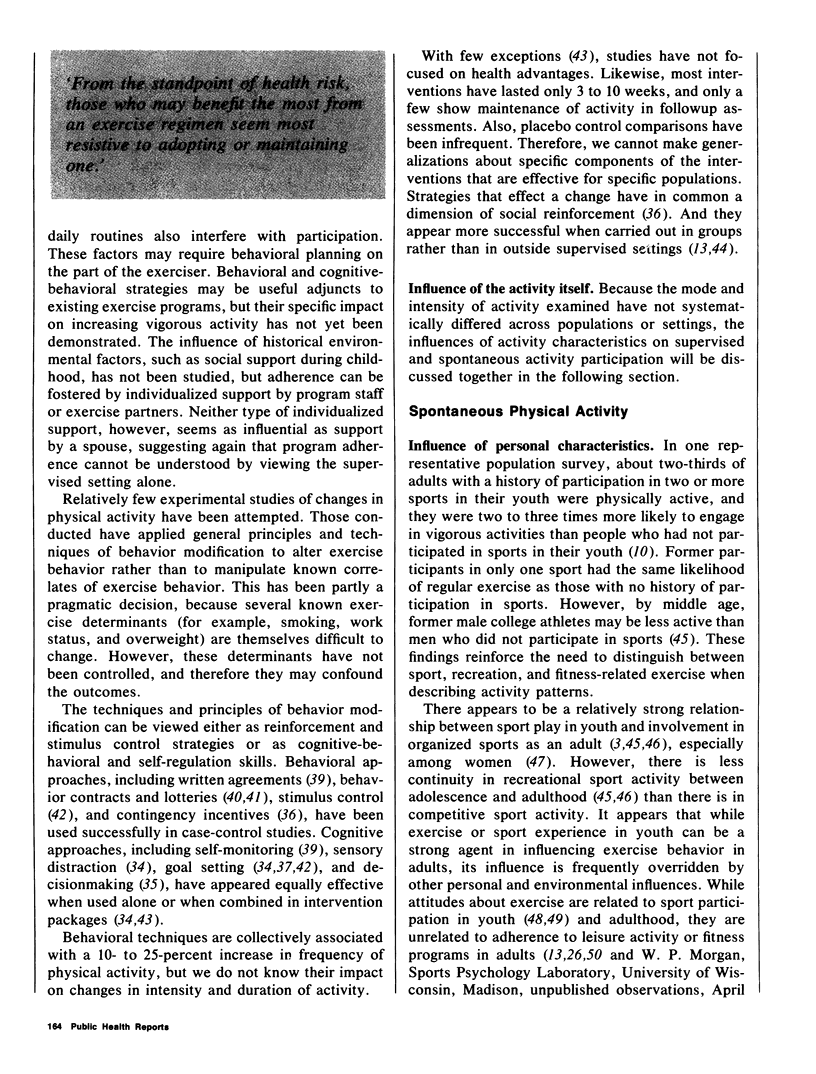
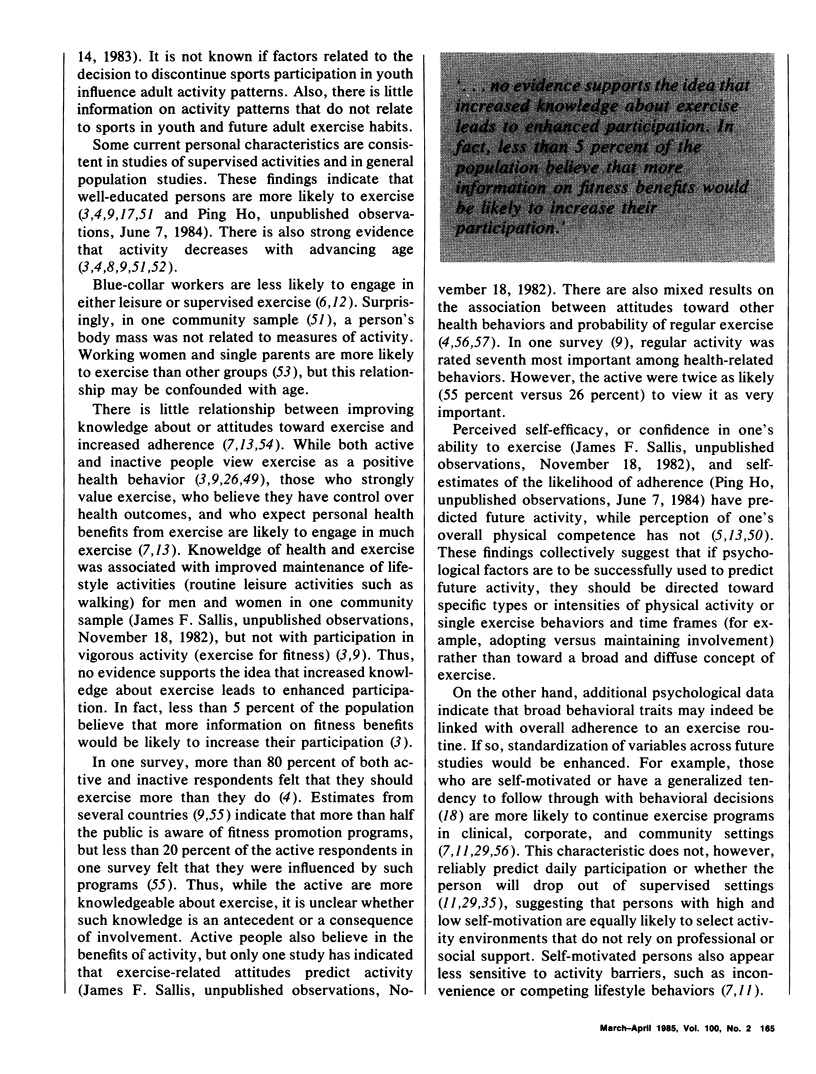
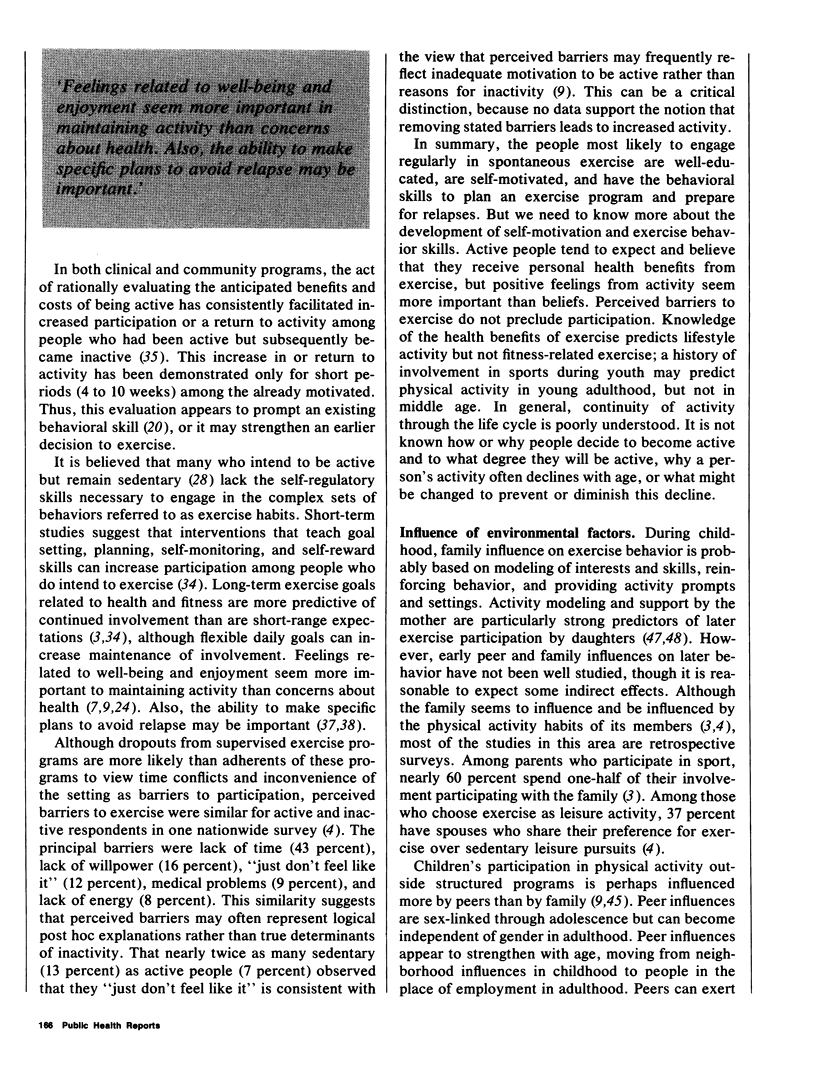
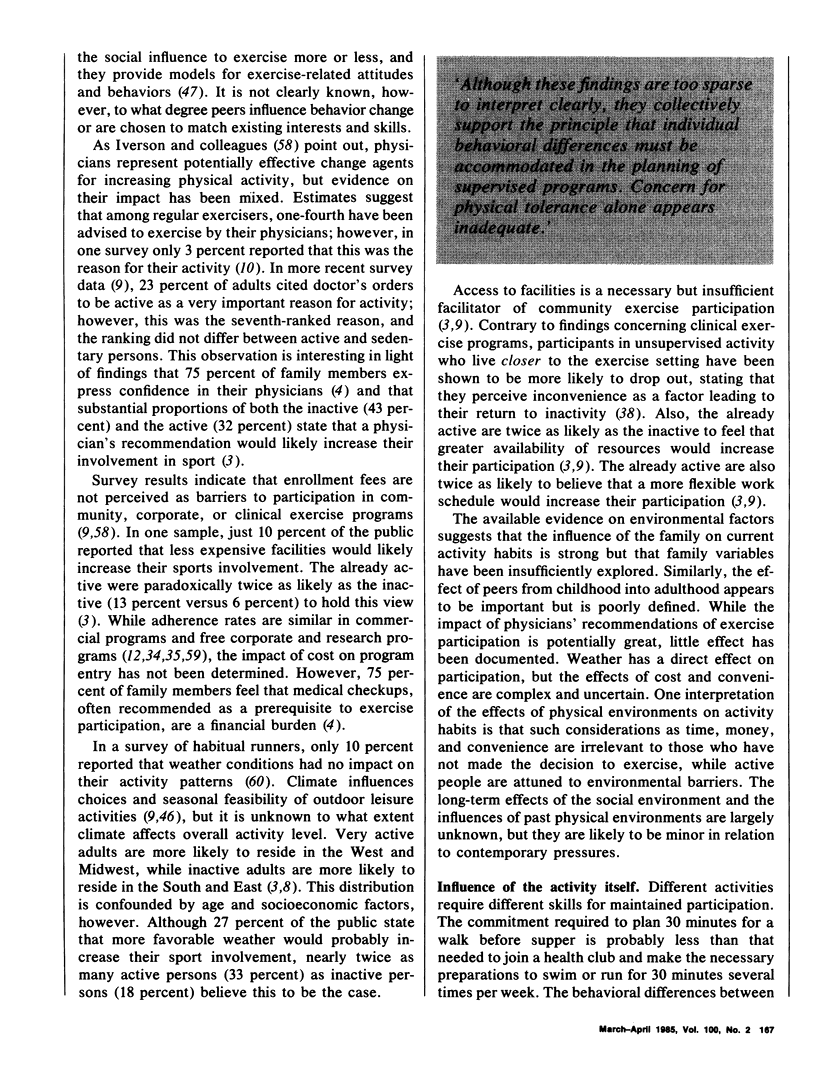
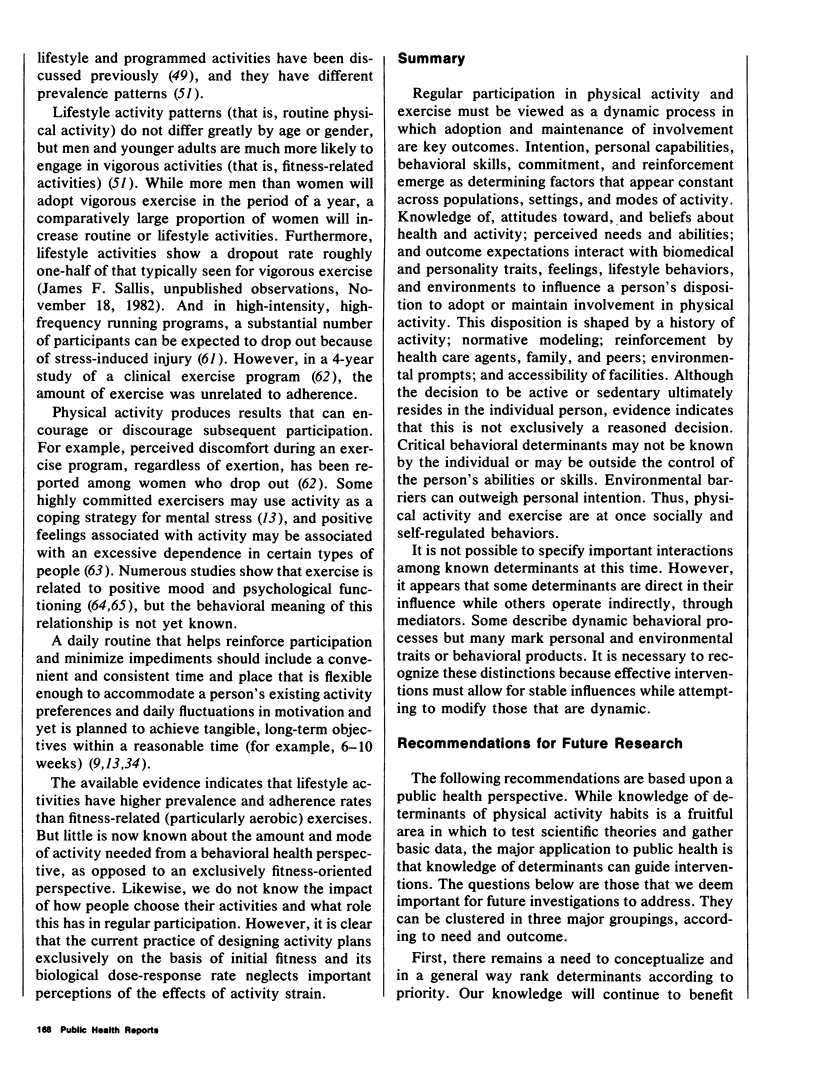
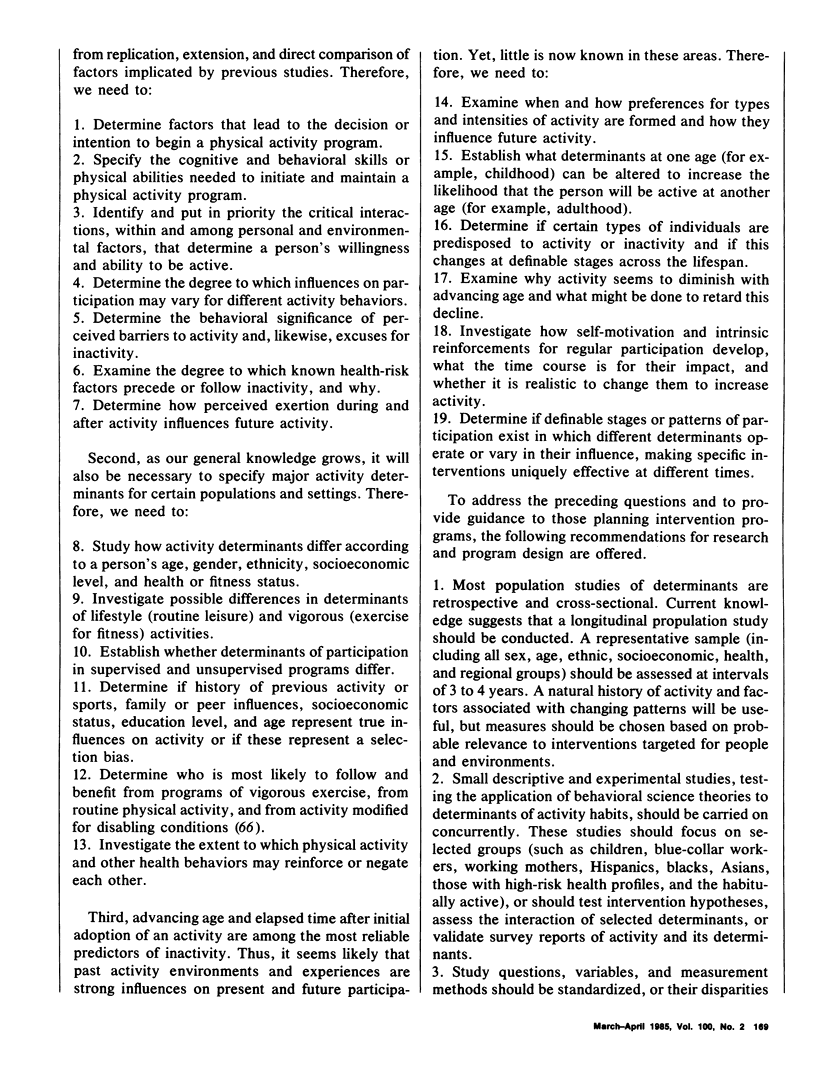
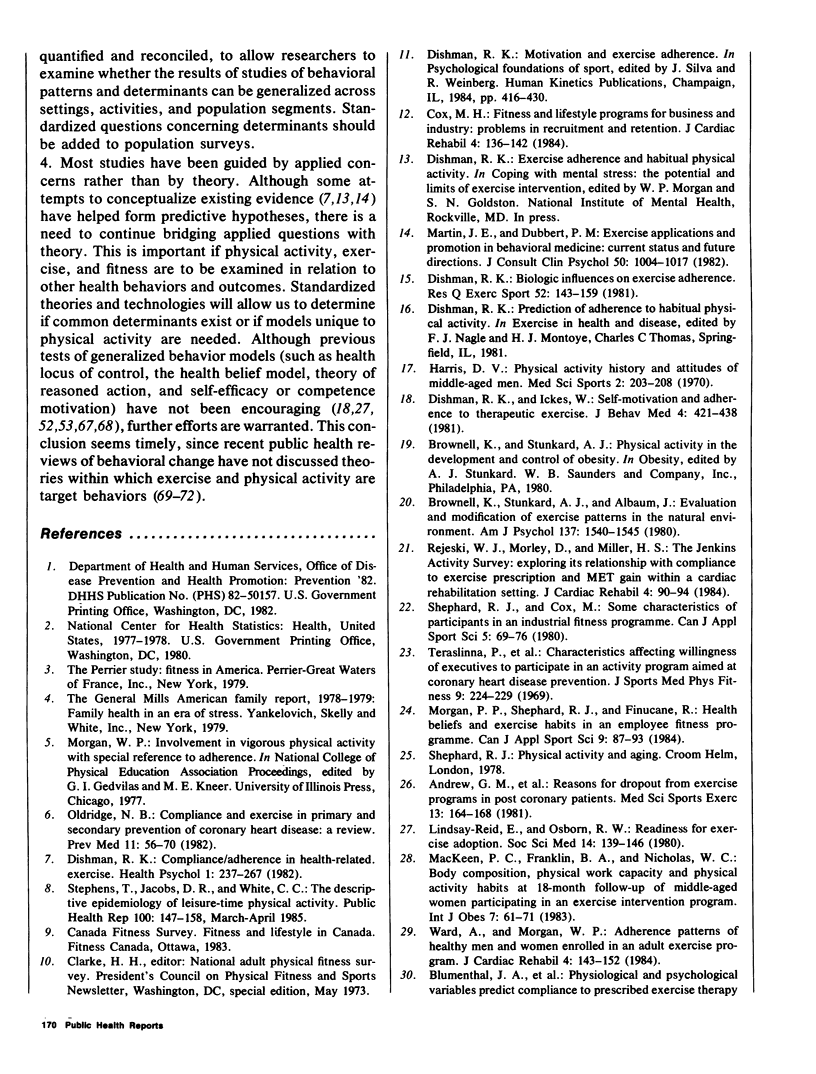
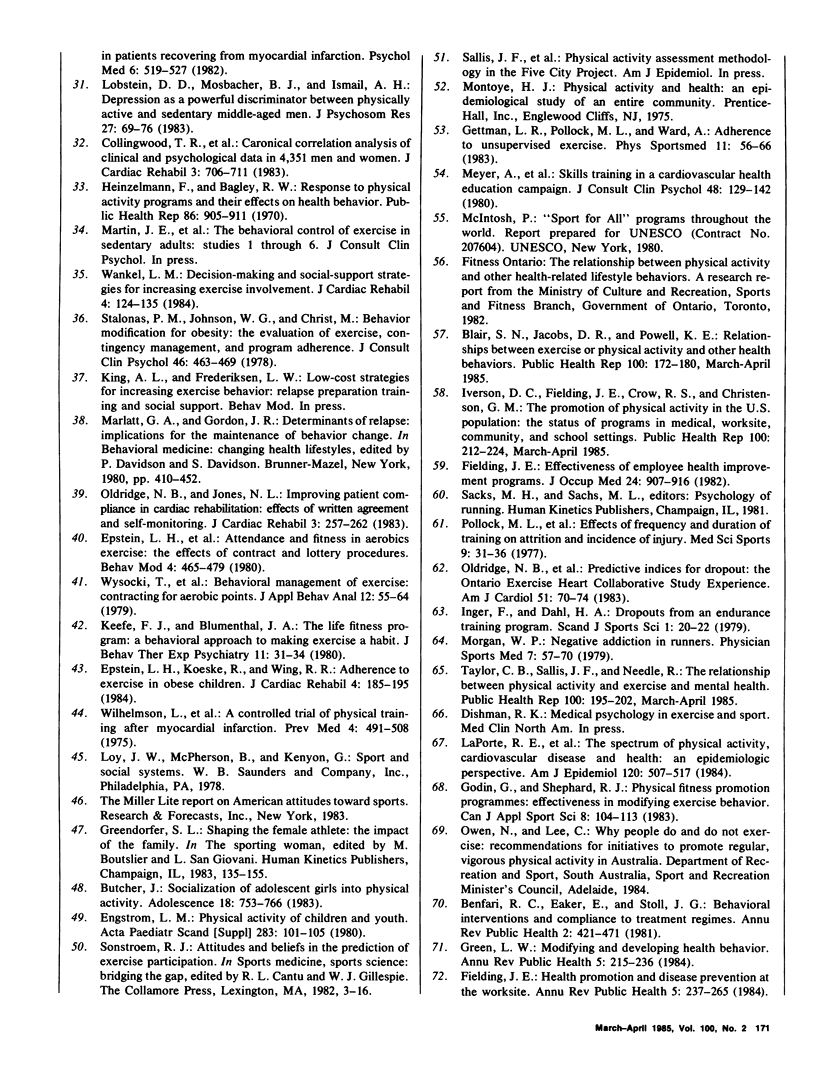
Selected References
These references are in PubMed. This may not be the complete list of references from this article.
- Andrew G. M., Oldridge N. B., Parker J. O., Cunningham D. A., Rechnitzer P. A., Jones N. L., Buck C., Kavanagh T., Shephard R. J., Sutton J. R. Reasons for dropout from exercise programs in post-coronary patients. Med Sci Sports Exerc. 1981;13(3):164–168. [PubMed] [Google Scholar]
- Benfari R. C., Eaker E., Stoll J. G. Behavioral interventions and compliance to treatment regimes. Annu Rev Public Health. 1981;2:431–471. doi: 10.1146/annurev.pu.02.050181.002243. [DOI] [PubMed] [Google Scholar]
- Blair S. N., Jacobs D. R., Jr, Powell K. E. Relationships between exercise or physical activity and other health behaviors. Public Health Rep. 1985 Mar-Apr;100(2):172–180. [PMC free article] [PubMed] [Google Scholar]
- Blumenthal J. A., Williams R. S., Wallace A. G., Williams R. B., Jr, Needles T. L. Physiological and psychological variables predict compliance to prescribed exercise therapy in patients recovering from myocardial infarction. Psychosom Med. 1982 Dec;44(6):519–527. doi: 10.1097/00006842-198212000-00003. [DOI] [PubMed] [Google Scholar]
- Brownell K. D., Stunkard A. J., Albaum J. M. Evaluation and modification of exercise patterns in the natural environment. Am J Psychiatry. 1980 Dec;137(12):1540–1545. doi: 10.1176/ajp.137.12.1540. [DOI] [PubMed] [Google Scholar]
- Butcher J. Socialization of adolescent girls into physical activity. Adolescence. 1983 Winter;18(72):753–766. [PubMed] [Google Scholar]
- Dishman R. K. Biologic influences on exercise adherence. Res Q Exerc Sport. 1981 May;52(2):143–159. doi: 10.1080/02701367.1981.10607852. [DOI] [PubMed] [Google Scholar]
- Dishman R. K., Ickes W. Self-motivation and adherence to therapeutic exercise. J Behav Med. 1981 Dec;4(4):421–438. doi: 10.1007/BF00846151. [DOI] [PubMed] [Google Scholar]
- Engström L. M. Physical activity of children and youth. Acta Paediatr Scand Suppl. 1980;283:101–105. doi: 10.1111/j.1651-2227.1980.tb15329.x. [DOI] [PubMed] [Google Scholar]
- Fielding J. E. Effectiveness of employee health improvement programs. J Occup Med. 1982 Nov;24(11):907–916. [PubMed] [Google Scholar]
- Fielding J. E. Health promotion and disease prevention at the worksite. Annu Rev Public Health. 1984;5:237–265. doi: 10.1146/annurev.pu.05.050184.001321. [DOI] [PubMed] [Google Scholar]
- Godin G., Shephard R. J. Physical fitness promotion programmes: effectiveness in modifying exercise behaviour. Can J Appl Sport Sci. 1983 Jun;8(2):104–113. [PubMed] [Google Scholar]
- Green L. W. Modifying and developing health behavior. Annu Rev Public Health. 1984;5:215–236. doi: 10.1146/annurev.pu.05.050184.001243. [DOI] [PubMed] [Google Scholar]
- Harris D. V. Physical activity history and attitudes of middle-aged men. Med Sci Sports. 1970 Winter;2(4):203–208. [PubMed] [Google Scholar]
- Heinzelmann F., Bagley R. W. Response to physical activity programs and their effects on health behavior. Public Health Rep. 1970 Oct;85(10):905–911. [PMC free article] [PubMed] [Google Scholar]
- Iverson D. C., Fielding J. E., Crow R. S., Christenson G. M. The promotion of physical activity in the United States population: the status of programs in medical, worksite, community, and school settings. Public Health Rep. 1985 Mar-Apr;100(2):212–224. [PMC free article] [PubMed] [Google Scholar]
- LaPorte R. E., Adams L. L., Savage D. D., Brenes G., Dearwater S., Cook T. The spectrum of physical activity, cardiovascular disease and health: an epidemiologic perspective. Am J Epidemiol. 1984 Oct;120(4):507–517. doi: 10.1093/oxfordjournals.aje.a113911. [DOI] [PubMed] [Google Scholar]
- Lindsay-Reid E., Osborn R. W. Readiness for exercise adoption. Soc Sci Med Med Psychol Med Sociol. 1980 Mar;14A(2):139–146. doi: 10.1016/0160-7979(80)90027-2. [DOI] [PubMed] [Google Scholar]
- Lobstein D. D., Mosbacher B. J., Ismail A. H. Depression as a powerful discriminator between physically active and sedentary middle-aged men. J Psychosom Res. 1983;27(1):69–76. doi: 10.1016/0022-3999(83)90111-3. [DOI] [PubMed] [Google Scholar]
- MacKeen P. C., Franklin B. A., Nicholas W. C., Buskirk E. R. Body composition, physical work capacity and physical activity habits at 18-month follow-up of middle-aged women participating in an exercise intervention program. Int J Obes. 1983;7(1):61–71. [PubMed] [Google Scholar]
- Martin J. E., Dubbert P. M. Exercise applications and promotion in behavioral medicine: current status and future directions. J Consult Clin Psychol. 1982 Dec;50(6):1004–1017. doi: 10.1037//0022-006x.50.6.1004. [DOI] [PubMed] [Google Scholar]
- Meyer A. J., Nash J. D., McAlister A. L., Maccoby N., Farquhar J. W. Skills training in a cardiovascular health education campaign. J Consult Clin Psychol. 1980 Apr;48(2):129–142. doi: 10.1037//0022-006x.48.2.129. [DOI] [PubMed] [Google Scholar]
- Morgan P. P., Shephard R. J., Finucane R., Schimmelfing L., Jazmaji V. Health beliefs and exercise habits in an employee fitness programme. Can J Appl Sport Sci. 1984 Jun;9(2):87–93. [PubMed] [Google Scholar]
- Oldridge N. B. Compliance and exercise in primary and secondary prevention of coronary heart disease: a review. Prev Med. 1982 Jan;11(1):56–70. doi: 10.1016/0091-7435(82)90005-6. [DOI] [PubMed] [Google Scholar]
- Oldridge N. B., Donner A. P., Buck C. W., Jones N. L., Andrew G. M., Parker J. O., Cunningham D. A., Kavanagh T., Rechnitzer P. A., Sutton J. R. Predictors of dropout from cardiac exercise rehabilitation. Ontario Exercise-Heart Collaborative Study. Am J Cardiol. 1983 Jan 1;51(1):70–74. doi: 10.1016/s0002-9149(83)80013-7. [DOI] [PubMed] [Google Scholar]
- Pollock M. L., Gettman L. R., Milesis C. A., Bah M. D., Durstine L., Johnson R. B. Effects of frequency and duration of training on attrition and incidence of injury. Med Sci Sports. 1977 Spring;9(1):31–36. [PubMed] [Google Scholar]
- Shephard R. J., Cox M. Some characteristics of participants in an industrial fitness programme. Can J Appl Sport Sci. 1980 Jun;5(2):69–76. [PubMed] [Google Scholar]
- Stalonas P. M., Jr, Johnson W. G., Christ M. Behavior modification for obesity: the evaluation of exercise, contingency management, and program adherence. J Consult Clin Psychol. 1978 Jun;46(3):463–469. doi: 10.1037//0022-006x.46.3.463. [DOI] [PubMed] [Google Scholar]
- Stephens T., Jacobs D. R., Jr, White C. C. A descriptive epidemiology of leisure-time physical activity. Public Health Rep. 1985 Mar-Apr;100(2):147–158. [PMC free article] [PubMed] [Google Scholar]
- Taylor C. B., Sallis J. F., Needle R. The relation of physical activity and exercise to mental health. Public Health Rep. 1985 Mar-Apr;100(2):195–202. [PMC free article] [PubMed] [Google Scholar]
- Teräslinna P., Partanen T., Koskela A., Oja P. Characteristics affecting willingness of executives to participate in an activity program aimed at coronary heart disease prevention. J Sports Med Phys Fitness. 1969 Dec;9(4):224–229. [PubMed] [Google Scholar]
- Wilhelmsen L., Sanne H., Elmfeldt D., Grimby G., Tibblin G., Wedel H. A controlled trial of physical training after myocardial infarction. Effects on risk factors, nonfatal reinfarction, and death. Prev Med. 1975 Dec;4(4):491–508. doi: 10.1016/0091-7435(75)90035-3. [DOI] [PubMed] [Google Scholar]
- Wysocki T., Hall G., Iwata B., Riordan M. Behavioral management of exercise: contracting for aerobic points. J Appl Behav Anal. 1979 Spring;12(1):55–64. doi: 10.1901/jaba.1979.12-55. [DOI] [PMC free article] [PubMed] [Google Scholar]


